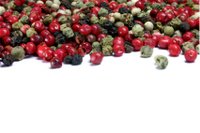
You may recall my efforts to find out about a "Basque Pepper" I'd heard Cat Cora describe in some Iron Chef dish she was whipping together. The
Food Network ticked me off with a cursory reply along the lines of:
"we don't give recipes, thank you for your interest and keep enjoying the shows."Sounds so genuine, doesn't it?
I didn't ask for a recipe, simply the name of an ingredient that Alton somehow skipped over and I hadn't heard of before... I was in the process of reviewing
The Cuisines of Spain cookbook by Teresa Barrenechea and thought it would be a timely side-note for my Suite101 readers (you have been reading me there, right?)
I don't mind admitting that I can be tenacious as hell when I've got my mind set on something. Imagine a dog with a knotted sock in its mouth, wait, not a good image...never mind. Let's just say,
very tenacious.
I've found the elusive
Basque Pepper. For an excellent primer and a few recipes to boot, please see
Dave's Pepper Pages.
Piment d'Espelette is a pepper of the capsicum (
nightshade family) variety; not the
Peppercorn family(
piper nigrum). The exotic branches of
that family tree are well-worth investigating. Balinese Long Pepper? Kampot Pepper for Lover Sauce?
Basques have worshipped their Piment d'Espelette for ages. It has become identified with their food and their region, their culture. Recently, it's attained controlled-name status, such as champagnes or bordeaux enjoy. If you're eating a "Basque pepper" it is most likely from one of the ten
AOC (Appellation d'Origine Controlee) communities.
Other than my Hungarian ancestors, Basques seem to be the

few Europeans who've adopted a fiery pepper in this way. On a recent trip to Toronto, I spent the better part of an afternoon in the funky
Kensington Market. If the Community Garden in a car doesn't define "funky" I don't know what would. Maybe the three kids on the sidewalk directly opposite the car, stoned out of their minds, each playing a single note on their respective guitars and trying, mostly unsuccessfully to match those notes with their voices and each other.
(I didn't have the heart to photograph them. What if they grow up and run for office or something? This explains why I will never make the fortune that "Girls gone wild" guy has made...)
In addition to the entertainment value, there are terrific vendors of just about anything. Truly. Spices? Seafood? "Glass art?" Coffee? Empanadas? You name it, I would bet my last looney you could find it there. It was in one of the amazing spice shops that I found ground
Piri Piri pepper. I had to buy it, knowing I had a vague notion it was (a) something I'd read about or heard of, and (b) something I'd not seen in my local markets.
Buy now, figure out later. Words to live buy. You can quote me on that one.
So, it turns out this fabulous little pepper is beloved in North Africa, Brazil and other places. The cool Portuguese stall in the
St. Lawrence Market (the dressed up for tourists version of Kensington) had a barbecued chicken with piri-piri sauce. Delicious but fiery.
I did a little research and used the powdered piri-piri to make my very own sauce. We marinated two split chicken breasts then baked them. It was the most flavorful, moist chicken breast I've ever had. Almost good enough to turn this dark meat girl into a white meat lover...
Piri-Piri Sauce
1 lge clove of garlic minced or mashed w/1 tsp kosher salt
1 TBSP Each: chopped green onion, grated carrot, grated white or yellow onion, chopped parsley
2 tsp red chilies (such as cayenne or Thai bird chilies)
4 TBSP ground Piri Piri pepper
1 TBSP Hungarian Pepper Paste (or use 1 TBSP tomato paste; adding more Piri Piri to taste)
1/3 C cider vinegar
¾ C Olive oil
The Hungarian Pepper paste was another great find! The St. Lawrence market has a great shop selling all kinds of gourmet products, among them these tubes of pepper paste. The labels are mostly in Hungarian (a good sign, in my book) so I asked whether this was like roasted red bell peppers, or like tomato paste we see in tubes...is it to be used in Paprikash? It is roasted Hungarian Paprika paste. Comes in Hot and Sweet. You know which I got, right?
Not only is it amazing in the Piri-Piri recipe above, but I've used it in other things. A little dab will do ya, as they used to say. I've located one place on the web which sells
Hungarian food products. While I haven't ordered from them myself, they guy has a photo of himself with an accordian -
how could it we go wrong?Coming soon: Paella!


 On Saturday and Sunday, October 14th and 15th, 2006 Wellfleet’s sixth annual OysterFest takes place down on the Cape. Shucking contests, cooking demonstrations, steel bands and more. If I weren't already otherwise engaged, you'd find me happily tasting my way through the various types of Wellfleet oysters now available.
On Saturday and Sunday, October 14th and 15th, 2006 Wellfleet’s sixth annual OysterFest takes place down on the Cape. Shucking contests, cooking demonstrations, steel bands and more. If I weren't already otherwise engaged, you'd find me happily tasting my way through the various types of Wellfleet oysters now available. You may recall my efforts to find out about a "Basque Pepper" I'd heard Cat Cora describe in some Iron Chef dish she was whipping together. The
You may recall my efforts to find out about a "Basque Pepper" I'd heard Cat Cora describe in some Iron Chef dish she was whipping together. The